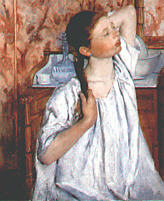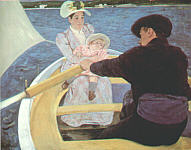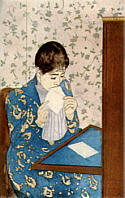
|
2245| 1
|
分享背景知识 Marry cassatt |
分享背景知识 Marry cassatt
Mary Cassatt is well known in North America. But when Europeans talk or write about Impressionism, names like Monet, Manet, Renoir, Sisley or Pissarro are mentioned. But few know the American woman artist Mary Cassatt. Is it because she was a woman and an American? Her beautiful art work has earned her a place in the pantheon of the great Impressionist artists. Born in PennsylvaniaMary Cassatt was born in 1844 in Pennsylvania, USA as the daughter of a wealthy merchant. At the age of seven her family left for Paris in France. After a few years of life in Paris, the family went back to the USA. Mary, impressed by all the art she had seen in Europe, surprised her parents by the wish to become an artist. Becoming an artist in the 19th century was as difficult for a woman as becoming a doctor. Society then had a different understanding of the role of women. An American Woman Artist in Paris Girl Arranging Her Hair | 1885-1886 | |
Finally Mary won and her parents allowed her to visit the Pennsylvania Academy of the Fine Arts. In 1866 she went back to Paris. She copied the old masters in the Louvre and other museums. The young woman artist had acquired pretty good skills in traditional art style and in 1872 a Mary Cassatt painting was even accepted by the judges of the Salon.
Then she got to know Edgar Degas, an artist from the group of Impressionists who were refused by the Salon and had established their own show, the Salon des Refuses. Edgar Degas introduced her to his friends Claude Monet, Auguste Renoir, Camille Pissarro and other Impressionist rebels.
Mary Cassatt and Edgar Degas became good friends. Some art historians think she also was his mistress. This is however rather questionable as Degas was considered a convinced misogynist. Under the influence of Edgar Degas and the other Impressionists the artist Mary Cassatt changed her painting style. She used light colors and began to paint people.

Mary Cassatt's favorite subjects became children and women with children in ordinary scenes. Her paintings express a deep tenderness and her own love for children. But she never had children of her own.
The artist's artistic breakthrough came in 1892, when she received a commission for a mural for the Woman's Building at the Chicago World's Fair. The mural painting got lost after the fair and has not shown up until today.

Mary Cassatt was also an excellent printmaker. After experimenting with different printmaking techniques like etching and aquatint she finally discovered drypoint combined with aquatint as her favorite intaglio process. Between 1889 and 1890 she created a set of twelve wonderful drypoints. From 1890 to 1891 she made a series of ten color prints, known as The Ten. This series is considered as a landmark in Impressionist printmaking. She continued to make prints until 1896.
Mary Cassatt prints show a strong influence of Japanese printmaking and later of Renaissance paintings.

Mary Cassatt influenced Impressionism not only as an artist. She also had an important role in sponsoring and in financial promotion of Impressionist art. She often bought paintings of her friends when they were short of cash. And with her connections to rich American families, she encouraged many of her countrymen to buy Impressionist art. Quite a few of the great Impressionist art collections in the USA were established as a result of her activities. The collection of 19th century French paintings of the Havemeyers was largely mediated by her. The collection is now in the New York Metropolitan Museum of Art.
The artist Mary Cassatt would have made a poor career as a diplomat. She never held back with her opinion. Fortunately her wealth made her independent from what others thought about her. Especially when she grew older, her frankness could sometimes become insulting.
She did not like the modern artists like Henri Matisse or Pablo Picasso and spoke of "dreadful paintings". Even her Impressionist colleagues were whacked. For Claude Monet's late works - his famous water-lily paintings - she found the words "glorified wallpaper".
She had one thing in common with Edgar Degas and that was poor eyesight. When she died in 1926 at the age of 82 she was blind.
| ||
手机版|ChaseDream|GMT+8, 2025-11-5 15:15
 京公网安备11010202008513号 京ICP证101109号 京ICP备12012021号
京公网安备11010202008513号 京ICP证101109号 京ICP备12012021号
ChaseDream 论坛
© 2003-2025 ChaseDream.com. All Rights Reserved.